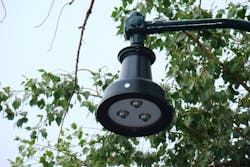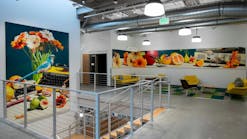Crossroads LED lighting at Santa Fe’s Railyard District demonstrates SSL reliability
Crossroads LED has revisited an outdoor solid-state lighting (SSL) project that the company supplied and reported no LED fixture failures or maintenance required. Moreover, the retrofit kits that were installed in vintage bell-shaped luminaire housings are still delivering uniform lighting with zero uplight relative to the BUG (Backlight, Uplight, and Glare) metrics for dark-sky-friendly lighting. The Crossroads project was in the Railyard District, a dining, arts, and entertainment district in Santa Fe, NM where local leaders wanted to conserve energy while maintaining a historic look and feel.
We first published a press release on the Railyard project in our Newsfeed back in 2017. The Prestige Series retrofit kits developed by Crossroads used Bridgelux Vero chip-on-board LEDs, a MeanWell driver, and LEDiL optics paired with each LED.
The city of Santa Fe had tested LED outdoor lighting in a number of settings early in the prior decade, but only began achieving satisfactory results around mid-decade as LED performance improved. City engineers tested Crossroads Prestige technology and confirmed that at 30-ft mounting heights it would deliver the desired 2-footcandle (fc) average illuminance. Efficacy was verified at over 130 lm/W with a 70W kit replacing 250W high-pressure sodium (HPS) lamps.
The city’s evaluation ultimately led to the retrofit of 80 HPS lights in the Railyard and roughly a 70% reduction in energy usage. The retrofits delivered a glare rating of 2 despite outputting 9100 lm with the drivers set for 70W.
Still, what caught our attention about the project and prompted this story is the demonstrated reliability. Frankly, we don’t publish enough accounts that cover whether an SSL project delivers on promises over time. And it appears careful thermal design and a multi-stage thermal mitigation scheme are key to the longevity of the Prestige retrofit kits.
Vice president of engineering Buddy Stefanoff said that the thermal design, encompassing conduction and convection, maintains LED die temperature at 57°C whereas the LEDs are rated for a typical die temperature of 105°C. The LEDs are mounted on a thermally-efficient substrate that handles first-stage thermal transfer to an extruded aluminum heat sink that serves as the second stage inside the luminaire assembly. The heat sink assembly is in turn bonded to the metal fixture housing that serves as the third thermal stage and allows dissipation of heat into the air.
Crossroads asserts that its thermal design is more efficient than what is found in most outdoor luminaires and results in significantly lower die temperature. Certainly, product specifications would have suggested that none of the Santa Fe retrofitted fixtures would have failed by now, but the documented fact that none failed is indicative of a robust design.
Stefanoff said Crossroads continues to use the same thermal approach in its newest products such as the Astrophile Series. That line of products is also noteworthy in that they are intended for settings where dark-sky concerns run to the extreme. We would also surmise that they might be useful around turtle habitats on coasts as we have covered several times recently.
The Astrophile Series of products uses amber LEDs to offer a choice of 2000K or 2200K CCTs. In this instance, the LEDs in question are phosphor converted for better efficacy than can be realized by monochromatic amber LEDs. Stefanoff said the designs are certified by the International Dark-Sky Association.
For up-to-the-minute LED and SSL updates, why not follow us on Twitter? You’ll find curated content and commentary, as well as information on industry events, webcasts, and surveys on our LinkedIn Company Page and our Facebook page.

Maury Wright | Editor in Chief
Maury Wright is an electronics engineer turned technology journalist, who has focused specifically on the LED & Lighting industry for the past decade. Wright first wrote for LEDs Magazine as a contractor in 2010, and took over as Editor-in-Chief in 2012. He has broad experience in technology areas ranging from microprocessors to digital media to wireless networks that he gained over 30 years in the trade press. Wright has experience running global editorial operations, such as during his tenure as worldwide editorial director of EDN Magazine, and has been instrumental in launching publication websites going back to the earliest days of the Internet. Wright has won numerous industry awards, including multiple ASBPE national awards for B2B journalism excellence, and has received finalist recognition for LEDs Magazine in the FOLIO Eddie Awards. He received a BS in electrical engineering from Auburn University.





